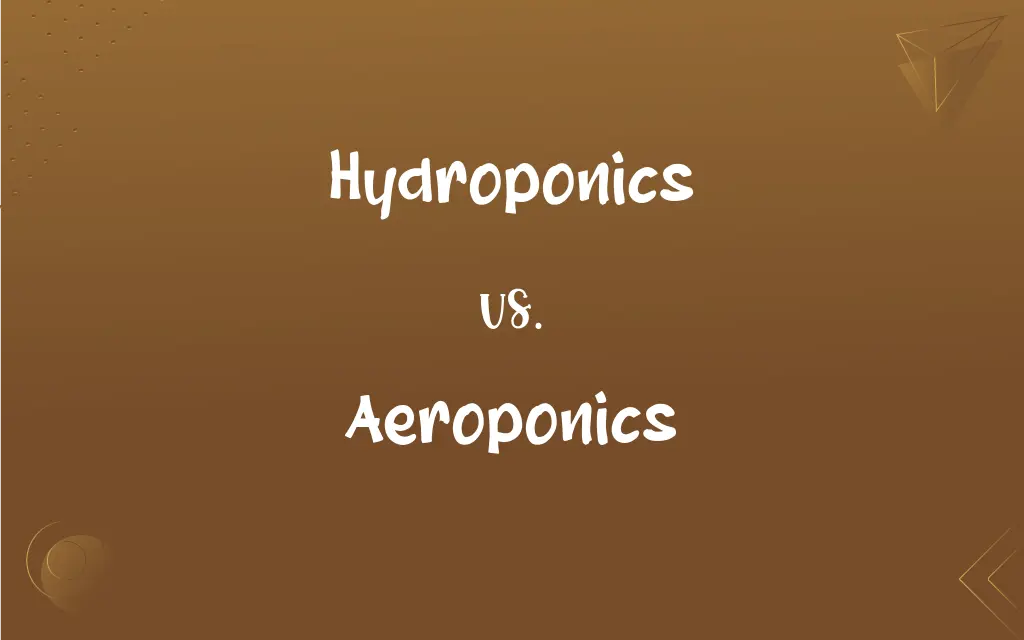Hydroponics vs. Aeroponics: What's the Difference?
Edited by Aimie Carlson || By Harlon Moss || Updated on October 26, 2023
Hydroponics involves growing plants in nutrient-rich water, while aeroponics uses misted nutrients in the air.

Key Differences
Hydroponics is a method of cultivating plants where they are grown in water enriched with essential nutrients. Aeroponics, on the other hand, is a system in which plant roots are suspended in air and periodically misted with a nutrient solution.
Hydroponics requires a reservoir to store the nutrient solution, ensuring plants have continuous access to water. In contrast, aeroponics utilizes a mist or spray system, delivering nutrients directly to the roots in intervals.
The main advantage of hydroponics is that it allows for precise control over nutrient levels, promoting rapid plant growth. Aeroponics, with its misting mechanism, ensures that plant roots receive ample oxygen, which can lead to even faster growth rates than hydroponics.
Both methods have the benefit of growing plants without soil, but the mechanisms by which they deliver nutrients vary significantly.
Comparison Chart
Medium
Nutrient-rich water
Air with misted nutrients
ADVERTISEMENT
Root Environment
Submerged in water
Suspended in air
Oxygen Access
From oxygenated water
Directly from the surrounding air
Nutrient Delivery System
Water pump and reservoir
Misting or spraying system
Typical Growth Rate
Fast due to precise nutrient control
Often faster due to ample oxygen to the roots
Hydroponics and Aeroponics Definitions
Hydroponics
Hydroponics is a soil-less cultivation method using nutrient-rich water.
With hydroponics, she grew tomatoes year-round.
ADVERTISEMENT
Aeroponics
Aeroponics involves suspending plant roots in air and delivering nutrients via mist.
With aeroponics, he could grow plants in vertical towers.
Hydroponics
Hydroponics involves growing plants directly in liquid nutrient solutions.
He converted his greenhouse to hydroponics and saw a yield increase.
Aeroponics
Aeroponics is the process where plants grow in an air/mist environment without soil.
Aeroponics systems require less water than traditional farming methods.
Hydroponics
Hydroponics allows for precise nutrient control by immersing plants in enriched water.
Many modern farmers are turning to hydroponics for its sustainability benefits.
Aeroponics
Aeroponics is a method where roots hang in the air and are sprayed with nutrients.
Due to its water efficiency, aeroponics is gaining popularity in arid regions.
Hydroponics
Hydroponics refers to the practice of nurturing plants in a controlled water environment.
The future of farming might shift more towards hydroponics given its efficiency.
Aeroponics
Aeroponics cultivates plants by misting their suspended roots with a nutrient solution.
Aeroponics has shown potential in NASA studies for space farming.
Hydroponics
Hydroponics bypasses traditional soil mediums, using water as the primary growth base.
Hydroponics systems in urban areas are revolutionizing local produce markets.
Aeroponics
Aeroponics refers to the growth of plants in a fog of nutrients without any medium.
The aeroponics farm downtown produces fresh greens faster than conventional methods.
Hydroponics
Cultivation of plants in nutrient solution rather than in soil.
Aeroponics
A technique for growing plants without soil or hydroponic media. The plants are held above a system that constantly mists the roots with nutrient-laden water.
Hydroponics
The cultivation of plants in a nutrient solution rather than in the soil.
Aeroponics
The growing of plants without either soil or hydroponics but in a mist-laden atmosphere.
Hydroponics
A technique of growing plants (without soil) in water containing dissolved nutrients
FAQs
Are hydroponics systems water-efficient?
Yes, hydroponics systems typically use less water than traditional soil-based cultivation.
How does aeroponics differ from hydroponics?
Aeroponics grows plants with roots suspended in air, misted with nutrients, while hydroponics submerges roots in nutrient-rich water.
Which is faster in terms of growth, hydroponics or aeroponics?
Both can achieve rapid growth, but aeroponics often has a slight edge due to better oxygen access.
How is the nutrient solution in aeroponics prepared?
Nutrient solutions for aeroponics are mixed with water based on specific plant needs and system recommendations.
Can hydroponics be practiced at home?
Yes, there are many hydroponics kits and DIY setups suitable for home use.
How do plants get oxygen in aeroponics?
In aeroponics, plant roots are exposed to air, allowing direct access to oxygen.
How are diseases managed in hydroponics?
Hydroponics systems often have fewer pests and diseases, but proper hygiene and monitoring are crucial.
How much space does hydroponics require?
Hydroponics can be adapted to various spaces, from small indoor systems to large greenhouses.
What are the main challenges of hydroponics?
Hydroponics challenges include nutrient balance, system maintenance, and initial setup costs.
Do hydroponics systems require a lot of maintenance?
Regular monitoring and adjustments are essential in hydroponics, but maintenance levels depend on the system's complexity.
What is hydroponics?
Hydroponics is a method of growing plants in a water-based, nutrient-rich solution without soil.
How do plants in hydroponics receive nutrients?
In hydroponics, plants absorb nutrients directly from the enriched water they're immersed in.
What are the benefits of aeroponics over traditional farming?
Aeroponics offers faster growth, less water use, and potential for vertical farming.
Can hydroponics systems be organic?
Yes, hydroponics can be organic if using organic nutrient solutions and pest control methods.
Is aeroponics a new technology?
While aeroponics has gained recent popularity, the concept has been around for decades.
Is aeroponics sustainable for large-scale farming?
Aeroponics is scalable, and with proper design, it can be sustainable for large-scale operations.
Do hydroponics and aeroponics need sunlight?
Both methods can utilize natural or artificial light sources, depending on the setup.
Is aeroponics suitable for all types of plants?
While many plants thrive in aeroponics, research is essential to determine the best fit for specific species.
How frequently are plants misted in aeroponics?
Misting frequency varies but often occurs at regular intervals to ensure roots stay moist.
Are aeroponics systems energy-intensive?
Aeroponics requires energy for misting and lighting, but efficiencies vary by design.
About Author
Written by
Harlon MossHarlon is a seasoned quality moderator and accomplished content writer for Difference Wiki. An alumnus of the prestigious University of California, he earned his degree in Computer Science. Leveraging his academic background, Harlon brings a meticulous and informed perspective to his work, ensuring content accuracy and excellence.
Edited by
Aimie CarlsonAimie Carlson, holding a master's degree in English literature, is a fervent English language enthusiast. She lends her writing talents to Difference Wiki, a prominent website that specializes in comparisons, offering readers insightful analyses that both captivate and inform.































































